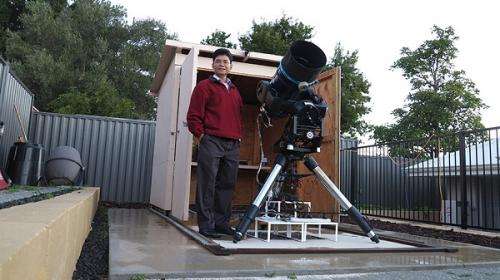Perth's planet hunter helps discover unusual exoplanet

An amateur Perth astronomer is part of an international team which has discovered a new and unusual planet orbiting outside the solar system.
Thiam Guan or 'TG' Tan is a Perth engineer by day and a planet hunter by night—he has co-discovered six planets from his backyard observatory.
He says he was looking for a new challenge for his skills and equipment when he started hunting exoplanets—planets which orbit outside the solar system and are very difficult to detect because they are small, faint and often lost in the glare of the bright stars they orbit.
Unusually the newly discovered exoplanet orbits one member of a pair of stars in a binary star system, nearly ignoring the companion star—most discovered exoplanets orbit single stars.
Its discovery suggests that a population of yet unseen terrestrial planets may orbit single members of binary pairs, expanding astronomers' 'hunting ground' for life on other planets.
"We've not found many planets in binary star systems, which makes this a significant discovery," Mr Tan says.
"The theory so far has been that the formation of planets around binary star systems would be difficult because the movement of the two stars around each other would lead to instability in the gravitational field and disrupt the formation of planets.
Exoplanet same distance from star as Earth to Sun
"In this case we have a planet orbiting one star and it is the same distance as we are from the sun."
"The ultimate goal of this type of research is to find habitable planets where life can form and these planets need to be far enough from their star to maintain a comfortable temperature."
Amateurs make exciting contributions to microlensing
Mr Tan says the method of discovery makes the search exciting. Researchers use microlensing—based on Einstein's Theory of Relativity, that detects planets regardless of how little light they emit.
If two stars are perfectly aligned in the sky, the gravity of the front one (the lens), bends the light from the one at the back into an annulus or Einstein ring. The change in the light curve indicates an exoplanet.
Mr Tan's role in the international research began when he posted data on a public website of exoplanet transits, where the light dips minutely when the planet passes in front of a star.
His observations became part of microlensing data sets taken from a worldwide network of sophisticated and amateur telescopes including large telescopes in New Zealand and Chile which survey the sky.
More information: "A terrestrial planet in a ~1-AU orbit around one member of a ∼15-AU binary." A. Gould, et al. Science 4 July 2014: 345 (6192), 46-49. DOI: 10.1126/science.1251527
Journal information: Science
Provided by Science Network WA





















